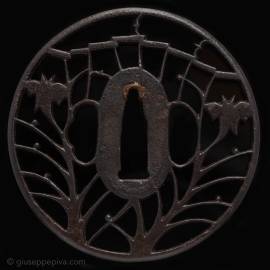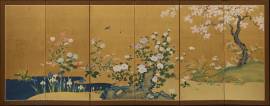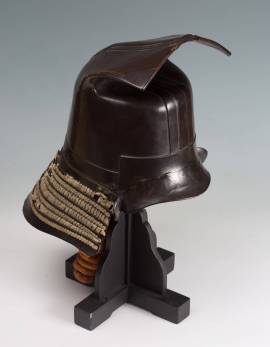Mumei, Edo Period, 17th CenturyIron, 8.3 x 8.2 x 0.5 cmNBTHK Hozon Tōsogu Specifications: Marugata tetsu-ji, ji-sukashi, kebori, marumimi Elegant iron tsuba with positive openwork yatsuhashi design, with the wooden eight-planked bridge on top, two large irises on the sides and geese on top. Yatsuhashi are wooden bridges that are staggered or set at angles, often seen in Japanese gardens. The theme derives from the 10th century Ise Monogatari tale: exiled from Kyoto after an affair with a high-ranking court lady, the story’s protagonist stops at Yatsuhashi, a place where a...
WORKS FOR SALE
Kano School, Edo period, 19th centurySix-panel folding screens; ink, color, gofun and gold leaf on paper107 by 268 cm The landscape shows a cherry tree in full blossom on the right side and a blue stream on the left. A Chinese-type rock typical of the Kano School artists is painted in the middle of the scene.Irises, peonies, lilies and poppies stand out among the many Spring and Summer flowers.Price band: 10,000€ - 25,000€ INVENTORY NR: byo-1593Japanese screens for sale. Price on application.
Kakukuzin-nari kawari kabutoHelmet shaped as a squared cloth headgearEarly Edo Period (1615-1867) 17th century Provenance:Kyoto, Arashiyama Museum Literature:Tetsu to urushi no geijutsu - Kyoto Arashiyama Bijutsukan zohinshu, Kyoto, 1986, pag. 26 Certificate: NKBKHK Tokubetsu Kichou Shiryo The kakuzukin, a type of headgear worn during the early Edo period, was formed by a rectangular cloth folded and sewn along the sides. This kabuto is shaped to resemble this kind of gear and, unlike similar known helmets, it bears in the center a simulation of multiple folds...
Copyright © 2016 - giuseppe piva - VAT: 05104180962










